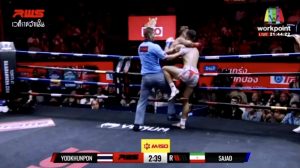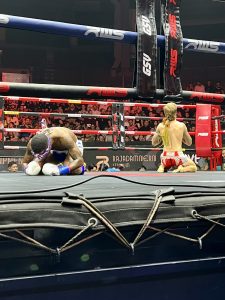
Rajadamnern Stadium program, April 15th, 2023
Thai Boxing, or Muay Thai, is a combat sport that originated in Thailand, also known as “The Art of Eight Limbs,” because it uses fists, elbows, knees, and shins to strike an opponent. It has a long and rich history in Thai culture and is deeply rooted in the traditions and customs of the country. In Thailand, Muay Thai is not only a sport but also an art, a way of life, and a symbol of national identity and pride.
I’m mentioning it because the Thai New Year, also known as Songkran, is upon us; celebrated annually from April 13th to 15th in Thailand. It is one of the most important festivals in Thai culture and is marked by water throwing, cleansing, and the renewal of good fortune. The celebration of Songkran is deeply rooted in Buddhism, and it is believed that water symbolizes purity and cleansing.
While the Thai New Year is a joyous occasion that brings people together, it is also a time when Muay Thai is celebrated and showcased. Many Muay Thai competitions and events are held during the Songkran festival, and it is an opportunity for fighters to display their skills and honor their culture.


Rajadamnern Stadium, April 15th, 2023.
However, while Muay Thai is deeply ingrained in Thai culture and is a source of national pride, it is not an appropriate Martial Art for primary aged children. I say this in spite of a huge number of young people who practice this form of Martial Art; many hundreds as young as four years old. And there are a number of professional Trainers and Coaches who develop carefully crafted syllabi to teach young children this cultural phenomenon as a physical education to improve fitness and movement coordination.

Rajadamnern Stadium Muay Thai bout, April 15th, 2023.
Recently, a friend of mine wrote an article entitled, “Why Muay Thai is a Great Choice for Parents Looking to Boost Their Children’s Brainpower“(1). In his article he argues that Muay Thai teaches children self-discipline, self-control, and respect for others and themselves. While this is often true of Martial Arts in general, not just Muay Thai, I have found it depends mostly on the Coach to impart those values, and they are most certainly not found in every Nak Mauy. Further he argues that Muay Thai will improve a child’s Myelin Sheath development, development of White Brain Matter and retention of White Brain Matter.
Martial Arts, in general, are a great activity for kids. And I believe that’s what the authors of the supporting articles my friend cites mean. But actually, none of those supporting articles mentions Muay Thai even once. The point being that while Martial Arts can offer a great deal of value to child development, not every Martial Art is for every child.
Firstly, Muay Thai is a combat sport that involves striking an opponent. While it may be argued that this is no different from other contact sports such as football or rugby, the fact remains that Muay Thai involves strikes to the head, body, and limbs that can cause serious injury. The risk of injury in Muay Thai is significantly higher than in other sports, and it is not a risk that should be taken lightly. Recently, Chatsuda Chandeeying, a Thai health official explained to a Thailand publication that the practice of Muay Thai by young children is a national concern. She cautions that, “…brain injuries will impair the young fighters’ education and well-being.”(2)

Performing the “Wai Kru” ceremony before the bout. Rajadamnern Stadium, April 15th, 2023.
Secondly, Muay Thai requires a high level of physical fitness and conditioning. Fighters must be able to endure long training sessions that include running, jump roping, weightlifting, and sparring. Primary aged children are not physically developed enough to undertake this kind of training without risking injury or harm. David Mitchell, who served as Chairman of England’s Martial Arts Commission, and authored numerous books on Martial Arts went so far as to say, “(Muay Thai) is quite unsuitable for persons under sixteen years of age.”(3)
Thirdly, Muay Thai is a Martial Art that requires a level of discipline and maturity that primary aged children may not possess. Muay Thai fighters must learn to control their emotions, remain calm under pressure, and respect their opponents. These are skills that take years to develop and are not appropriate for children who are still learning to control their impulses and emotions. In his book, The Young Martial Artist, David Mitchell cautions that, “Thai boxing is dangerously practical and ripe for misuse in the playground.”(3)

Rajadamnern Stadium, April 15th, 2023.
Finally, the culture of Muay Thai in Thailand is very different from that in other parts of the world. In Thailand, Muay Thai is deeply rooted in tradition and customs that are not always easily understood or appreciated by foreigners. Foreigners who practice Muay Thai are often referred to as “Farang Nak Muay”. Primary aged children and their parents may not be able to fully appreciate the cultural significance of Muay Thai. Western countries have put pressure on Thailand to more closely regulate how they view young children fighting Thai boxing bouts for money. Chatsuda Chandeeying say “this issue required prompt action because such competitions – in which the young fighters get paid for boxing – fell within the frame of child labour and abuse.”(2)
I have a passion for Muay Thai; a love for every aspect of the art/sport. But in my opinion, while Muay Thai is an important part of Thai culture and is celebrated during the Thai New Year, it is not appropriate Martial Art for primary aged children to participate. The risks of injury, the physical demands of training, the need for discipline and maturity alone make it unsuitable for young children. While it is important to honor and respect the traditions of other cultures, it is equally important to ensure the safety and well-being of young children.

Songkran celebration at Rajadamnern Stadium, April 15th, 2023.
I’ve designed my Mat Monkeys curriculum specifically for young children about 4 years of age to about 9 years of age. Mat Monkeys is physical education for primary age children to help develop physical fitness, good character, self-confidence and a philosophy that they can defend themselves. In my opinion Judo is the best foundational Martial Art for primary age children. Jigoro Kano, the founder of Judo, gave us the world’s first modern Martial Art (4). He made Judo the national physical education of Japan. He instilled a moral code into the curriculum. Judo is an Olympic sport, but its moral code is what makes it the inheritors of the Samauri’s moral code and the seven virtues. My program is a recreational program. I believe it should be fun and not all kids, especially young kids need to compete. When kids get into the double digits, Judo competitions may be very beneficial for some kids. If a striking Martial Art is what a parent wants for their child, I might choose Karate or Taekwondo over Muay Thai. But this is the last thought I’ll leave you with: I teach my Mat Monkeys to close the distance quickly; hug aggressively; take the “bad guy” to the ground and control them. I’ve never heard a principal of any school say that a punch in the face is allowed; nor the kind of thing they’d endorse.
CITATIONS:
(1) Puu, J. 2023, Mar 15. “Why Muay Thai is a Great Choice for Parents Looking to Boost Their Children’s Brainpower”. LinkedIn. https://www.linkedin.com/pulse/why-muay-thai-great-choice-parents-looking-boost-childrens-puu.
(2) 2018, August 12. “Study Raises concerns about Young Muay Thai Fighters”. The National Thailand. https://www.nationthailand.com/in-focus/30352006.
(3) Mitchell, D. THE YOUNG MARTIAL ARTIST. Woodstock, New York. The Overlook Press. 1992.
(4) Kano, J. KODOKAN JUDO. Tokyo, Japan. Kodansha International. 1986.






